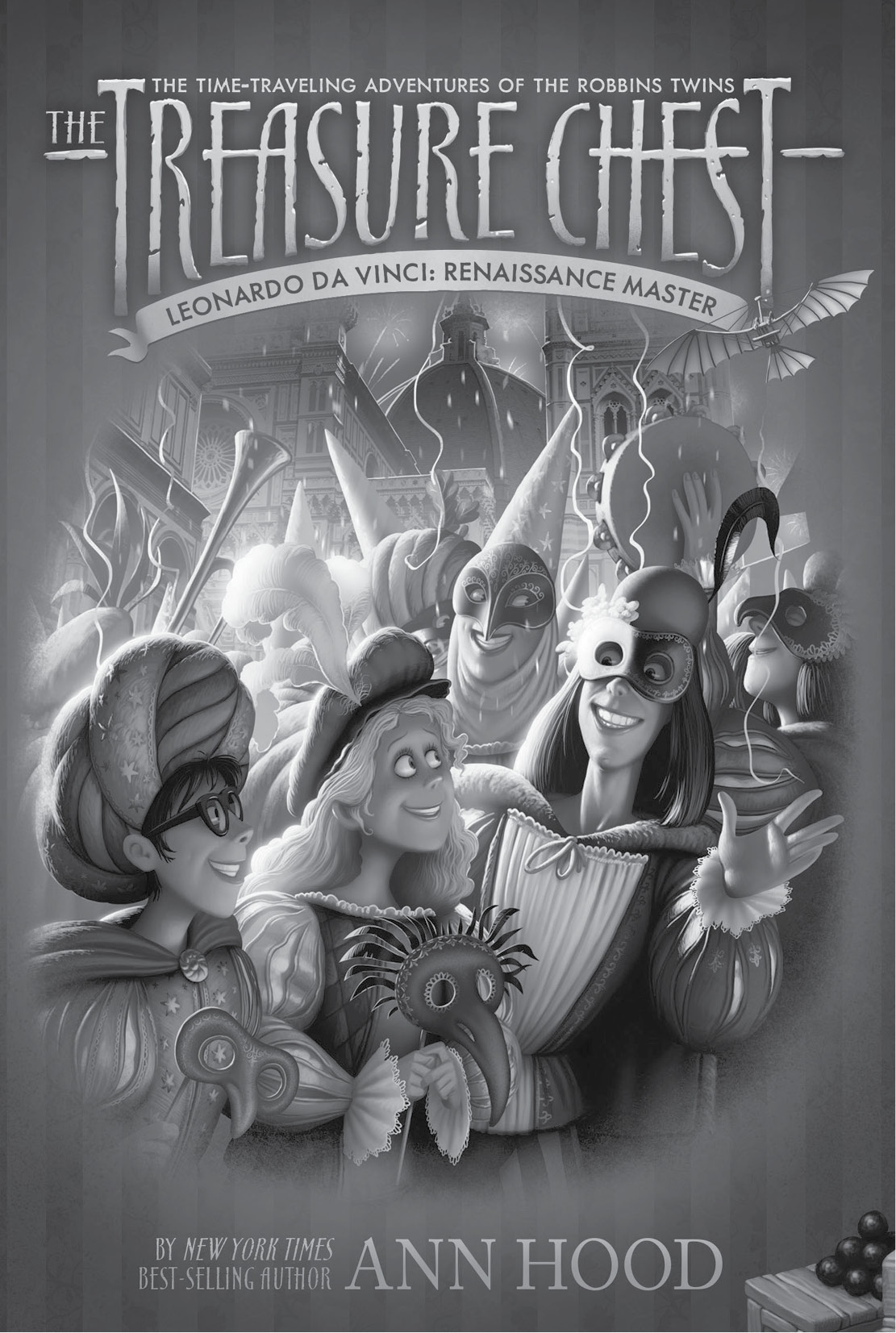Amelia Earhart: Lady Lindy (12 page)
Read Amelia Earhart: Lady Lindy Online
Authors: Ann Hood

ANN'S FAVORITE FACTS:
I do so much research for each book in The Treasure Chest series and discover so many cool facts that I can't fit into every book. Here are some of my favorites from my research for The Treasure Chest, No. 8:
Amelia Earhart: Lady Lindy.
Enjoy!
There are so many things that I'm excited about in book eight! First, there is Amelia Earhart herself. I read a biography of her when I was in second grade and became fascinated not only with her accomplishments but also with the mystery surrounding her disappearance. Since I first read about her when I was seven, there has been some progress on perhaps uncovering that mystery.
WHAT HAPPENED TO AMELIA EARHART?
There are many theories about what happened to Amelia Earhart. Some people believe that she simply crashed into the Pacific Ocean on that long-ago night and died as a result of that crash. This theory is known as the “crash and sink” theory: her plane crashed and sank into the ocean.
Others have a theory that her flight was an elaborate scheme by President Franklin D. Roosevelt to have her spy on the Japanese. The problem with this theory is that not only did she not go anywhere near Japan, but her mission was hardly a secret. In fact, it was one of the most publicized events of the century!
In 1943, during World War II, several Allied airmen reported seeing Earhart working as a nurse on Guadalcanal. The person they saw probably was Merle Farland, a nurse from New Zealand, who was said to resemble the lost pilot. Many of those airmen suffered delusions brought on by malaria and other diseases, which might have fueled their belief that Amelia Earhart was their nurse.
An Australian army corporal on patrol in the jungle on the island of New Britain near Papua New Guinea in 1943 found a Pratt & Whitney aircraft engine. Earhart's plane did have a Pratt & Whitney engine, as did many planes during that time. However, Earhart had radioed that she was running out of fuel near Howland Island, so she could not have flown another 2,000 miles to New Britain.
A 1970 book claimed that Earhart survived crashing in the Pacific and was taken as a prisoner of war by the Japanese. Later, the book continued, Americans discovered her and repatriated her to New Jersey where she lived under an assumed name as Irene Bolom. However, when the real Irene Bolom read the book, she denied this, sued the author, and won.
Another rumor circulated that Amelia Earhart had been captured by the Japanese. But this one claimed she was broadcasting over the radio as one of about a dozen English-speaking women collectively known as “Tokyo Rose,” who spread propaganda to disrupt the morale of the Allied troops. George Putnam investigated this rumor at the time and listened to dozens of Tokyo Rose broadcasts. He determined that none of the women was his Amelia Earhart.
Immediately after Earhart and Noonan's disappearance, the United States Navy and Earhart's mother expressed belief the flight had ended in the Phoenix Islands, about 350 miles southeast of Howland Island. In 1988, the International Group for Historical Aircraft Recovery, (TIGHAR), began an investigation of the Earhart/Noonan disappearance and since then has sent ten expeditions to the tiny coral atoll of Nikumaroro in the Phoenix Islands. They have suggested that Earhart and Noonan may have flown without further radio transmissions for two and a half hours along the line of position Earhart noted in her last transmission received at Howland, arrived at then-uninhabited Gardner Island (now Nikumaroro), landed on an extensive reef flat near the wreck of a large freighter, the SS
Norwich City
, and lived as castaways until they ultimately perished.
TIGHAR's research has produced a range of documented archaeological and anecdotal evidence supporting this hypothesis. For example, in 1940, a British colonial officer and licensed pilot named Gerald Gardiner, radioed his superiors to inform them that he had found a skeleton that was possibly a woman, along with an old-fashioned sextant box under a tree on the island's southeast corner. He was ordered to send the remains to Fiji, where British authorities took detailed measurements of the bones and concluded they were from a male about 5 feet 5 inches tall. However, in 1998 an analysis of the data by forensic anthropologists indicated the skeleton had belonged to a “tall white female of northern European ancestry,” a description that fits Earhart. Unfortunately, the bones were misplaced in Fiji and have not been found.
In 2007, a TIGHAR expedition visited Nikumaroro searching for unambiguously identifiable aircraft artifacts and DNA. The group included engineers, technical experts, and others. Artifacts discovered by TIGHAR on Nikumaroro have included: improvised tools; an aluminum panel (possibly from an Electra); an oddly cut piece of clear Plexiglas the same thickness and curvature of an Electra window; a size-9 Cat's Paw heel dating from the 1930s, which resembles Earhart's footwear in world flight photos; a zipper pull that might have come from her flight suit; and a shard of a cosmetics jar that matches an Earhart-era freckle creamâbut so far, nobody has found proof she used that brand.
During a 2010 expedition, the research group said it had found bones that appeared to be part of a human finger. TIGHAR believes that the evidence they have found is consistent with a castaway presence on the island. Among the most interesting are the remains of small fires with bird and fish bones; giant clams that had been opened like New England oysters; empty shells laid out as if to collect rainwater; pieces of a pocket knife; pieces of rouge and the broken mirror from a woman's compact; and prewar American bottles with melted bottoms that had once stood in a fire as if to boil drinking water. The mysterious tiny finger bone was discovered near turtle remains on the island's remote southeast end, in an area called the Seven Site, where campsite and fire features were also found.
Earhart's surviving stepson, George Putnam Jr., has expressed support for TIGHAR's research.
Another thing that excited me as I wrote
Lady Lindy
was the opportunity to write about mountain gorillas. In 2011, my sixteen-year-old son, Sam, and I visited Uganda in Africa. During the week, we taught in lower and middle schools (he taught acting and I taught writing). On the weekends, we traveled to all of the beautiful national parks around the country and saw lions, zebras, hippos, rhinos, giraffes, wildebeests, and more birds than I can document here. On our last weekend, we went to the Bwindi Impenetrable Forest, where the world's remaining mountain gorillas live. Bwindi borders the Congo, and the gorillas move freely between the countries.
Mountain gorillas are endangered. Less than 790 remain in the wild, and there are none in captivity. Many factors have contributed to their endangered status, including habitat loss, poaching, and snares meant for small game. Recently, mountain gorillas have also become the victims of neighboring human warfare.
Bwindi Impenetrable Forest has earned its name! Like the jungle where Maisie and Felix land, it has thick foliage, vines, and no paths or trails. Guides with machetes hack through the vegetation to provide paths for visitors. Other guides have rifles in case of attacks by wild animals or poachers. Sam and I visited there during the rainy season, which added to the difficult conditions.
Although we had been prepared to hike as much as seven hours into the jungle to spot the gorillas, we got lucky and saw four gorillas within about twenty minutes. They ate bark and leaves, very much like the ones that Maisie and Felix first encounter. In fact, the behavior I described in the book is what we observed. About an hour later, our guide got a walkie-talkie report that there was a silverback gorilla another ten minutes deeper in the jungle. We hiked there, and, sure enough, we found the silverback!
We had been instructed not to make eye contact with a gorilla and to keep at least ten feet away from them. But the silverback was immediately curious about
us
, and marched right over. Our guide reminded us to look at the ground, not the gorilla, and to stand very close together. I could smell him as he approached and walked right up to us, standing about a foot away and walking up and down the line we had formed.
When he got to me, he stopped for what seemed a very long time. I could hear him breathing and up close he smelled even worse! Eventually, he moved away. But just when I sighed with relief, he came up behind me and punched me hard right between the shoulder blades, sending me flying through the air. I heard Sam yell and run up to catch me, just as the gorilla started to come toward me. One of the guides picked me up and stuck me in the trunk of a dead tree, ordering everyone else to form a tight circle around me. For what seemed like forever, the silverback circled us, panting and pounding his chest, until he finally gave up. But first, he hip-checked the guide hard enough to knock him down. Only later did I learn that the silverback's nickname is “The Puncher”!
Finally, I was excited to write about women and aviation. When I got out of college, I worked as a flight attendant for TWA, the very airline that Amelia Earhart worked for! Unlike her, I did not have a desire to
fly
planes. But I did have a burning desire to travel and see the world. The first airline stewardess (that's what we were called until airlines began hiring men for the job in the 1970s), Ellen Church, worked for what later became United Airlines. The first stewardesses had to be registered nurses, but eventually the profession became synonymous with pretty young women, even though their main role on the plane is to evacuate it during emergencies. Until the late 1960s, stewardesses could not keep their jobs if they got married. That changed slightly, allowing them to marry but forcing them to quit if they had children. By the time I became a flight attendant, the image had changed, partially because men were now doing the job but also because the role of women had changed over time. In 1978, when I started working as a TWA flight attendant, there were still only a handful of female pilots flying for commercial airlines. Today, there are over 5,200. Amelia Earhart would be proud!
Continue your adventures in The Treasure Chest!


